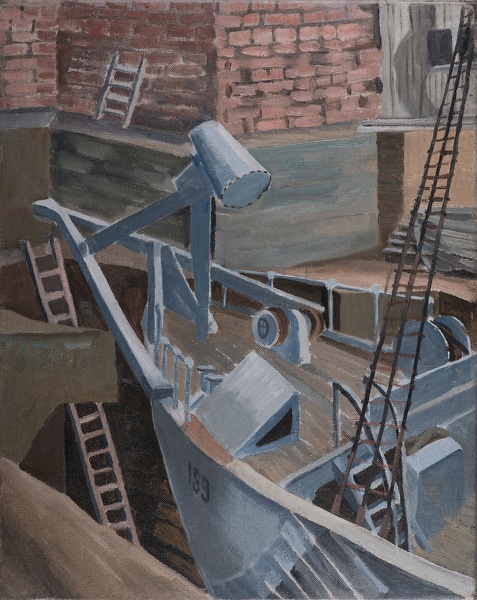
A Royal Navy Mine Sweeper in Dry Dock, circa 1940
Framed (ref: 9217)
Signed and titled to reverse
Tags: Isobel Atterbury Heath oil war Fifty Works by Fifty British Women Artists 1900 - 1950 WOMEN

Tags: Isobel Atterbury Heath oil war Fifty Works by Fifty British Women Artists 1900 - 1950 WOMEN
Provenance: Private Collection
Britain in the Second World War was a country that can never be reclaimed. Even in what turned out to be the last years of its empire, the nation could still harness formidable resources of skilled labour and technology. Minesweepers, for instance: in the five years between the war’s start and D Day, the Royal Navy increased its fleet from around 40 to 1,200, many of them (like this dry-docked example in Atterbury Heath’s picture) made of wood to make them less vulnerable to magnetic mines. Another kind of mine, the acoustic, explains the strange bucketlike device on the ship’s bow. Mines that could be set off by noise were a new development in 1940, but by 1942 British scientists had developed a counter-measure called the acoustical hammer, which sat inside a conical steel box and when the button was pressed or the lever pulled made a tremendous noise – loud enough to detonate acoustic mines at a safe distance from the ship.
Both sides laid minefields – to damage enemy ships and to protect their own – but Britain developed a particular expertise in them. They caused significant losses to ships, cargoes and lives. German minefields are estimated to have sunk nearly 300 British warships and a similar number of merchant ships. British mines sent a total of more than 1,000 Axis ships of all kinds to the bottom. The shape of the bow on Atterbury Heath’s minesweeper suggests it belongs to the MMS type, of which more than 400 were built. They were small ships, built quickly; their acoustical hammers have a touch of Heath-Robinson. Sailors knew them as the ‘Mickey Mouse’ class. The work the Mickey Mice did was brave and invaluable.
Commentary by Ian Jack. Jack is a writer and journalist who has edited The Independent on Sunday and the literary magazine Granta. He writes regularly for The Guardian. He learnt to tell the difference between cruisers, destroyers, minesweepers, frigates and corvettes during his childhood on the Firth of Forth.